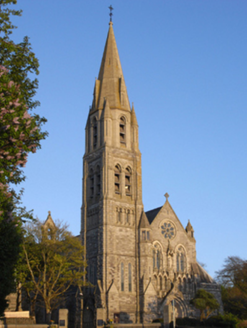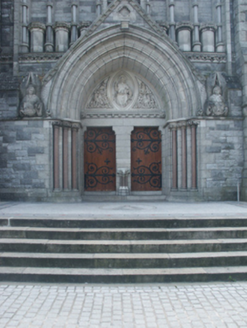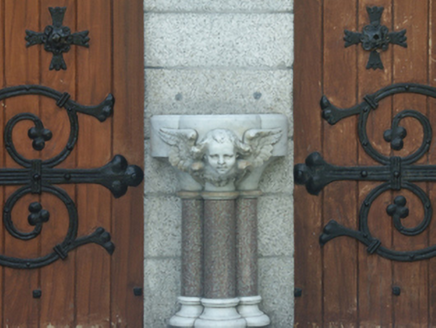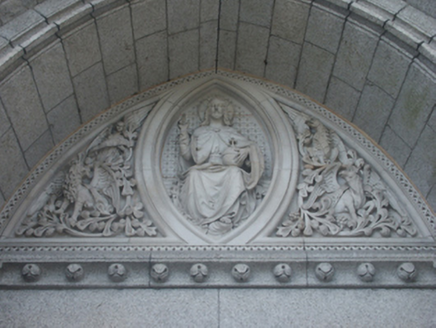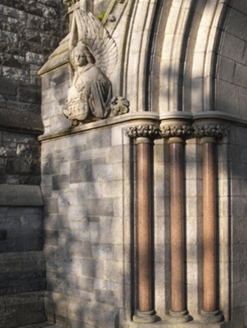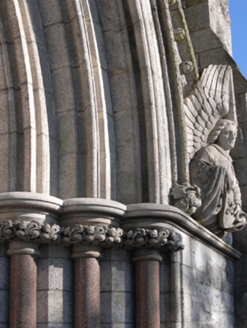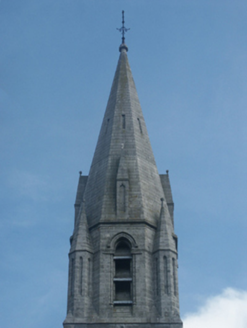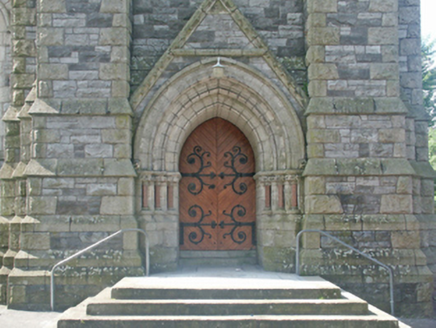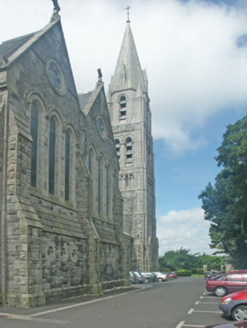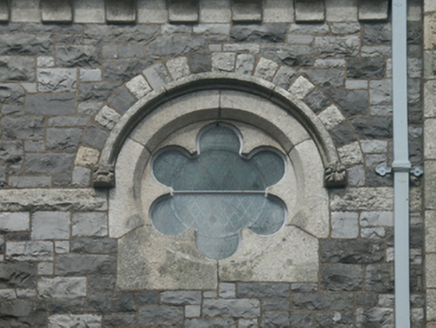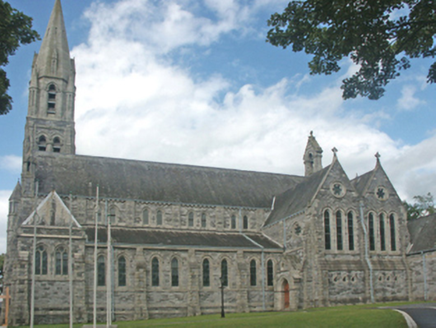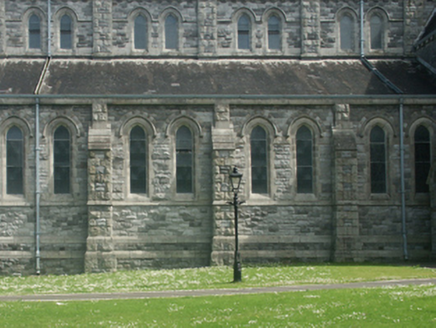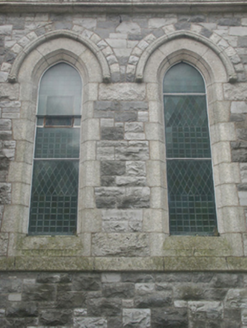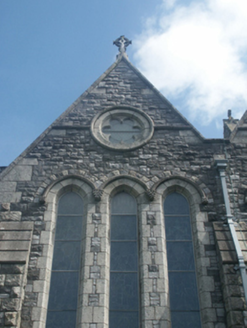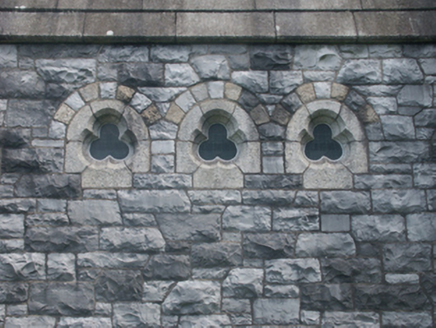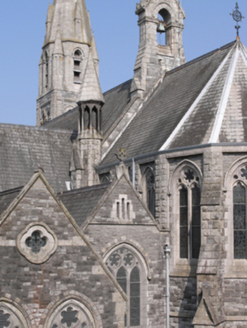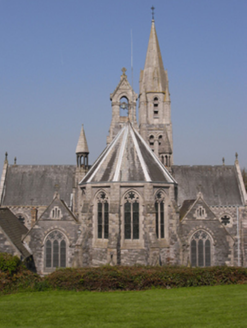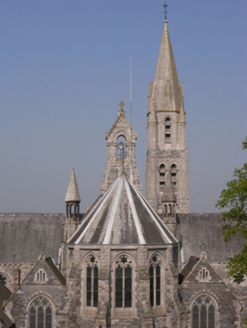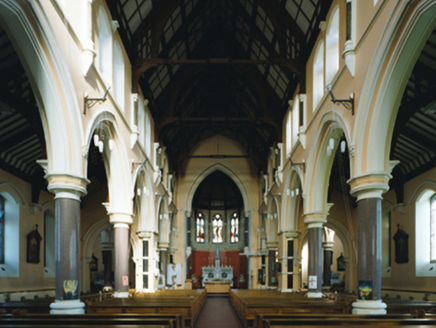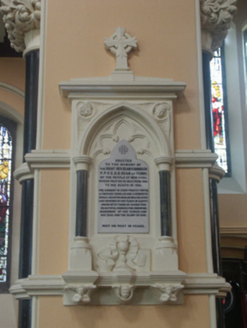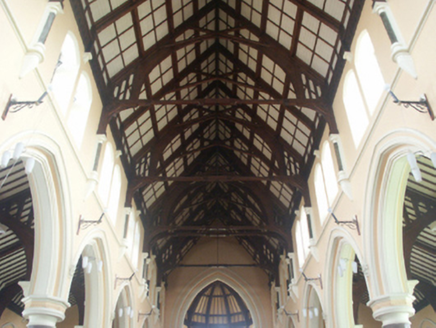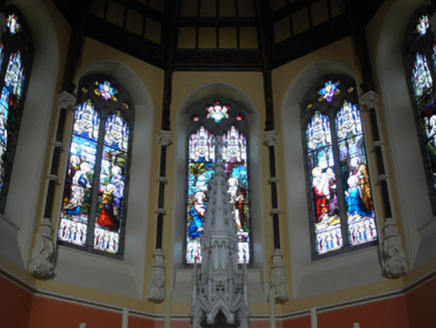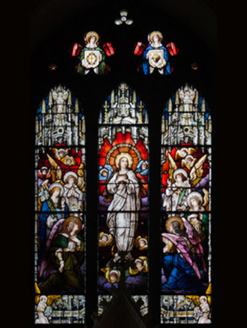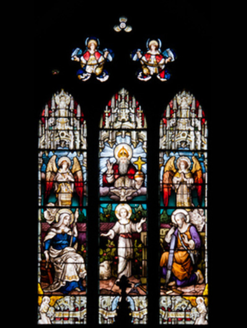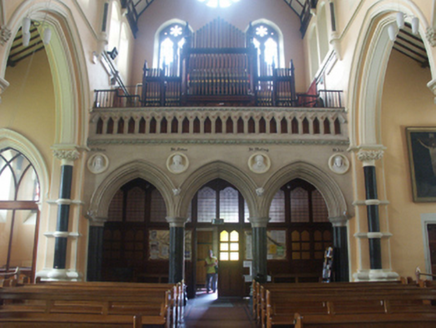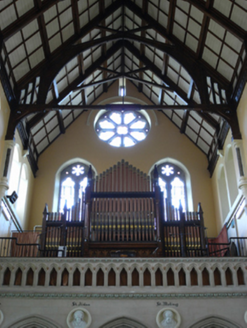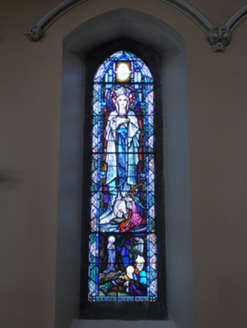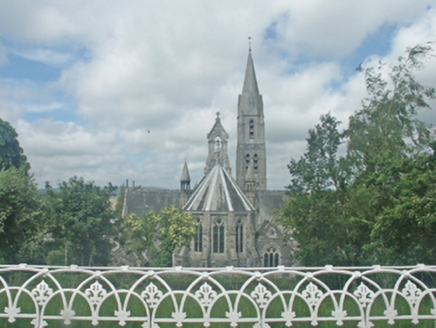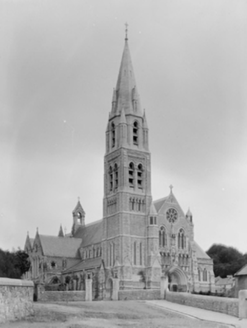Survey Data
Reg No
15605113
Rating
National
Categories of Special Interest
Architectural, Artistic, Historical, Social, Technical
Original Use
Church/chapel
In Use As
Church/chapel
Date
1890 - 1905
Coordinates
271967, 127271
Date Recorded
21/06/2005
Date Updated
--/--/--
Description
Detached eight-bay double-height Catholic church, designed 1894; built 1895-1902; opened 1902, on a cruciform plan comprising five-bay double-height nave opening into five-bay single-storey lean-to side aisles with single-bay (two-bay deep) double-height double-pile transepts centred on single-bay double-height apse to crossing on a projecting polygonal plan; single-bay six-stage tower (north-west) on a square plan supporting octagonal spire. Renovated, ----, with sanctuary reordered. Pitched slate roofs on a cruciform plan; lean-to slate roofs (side aisles); polygonal-ended pitched slate roof (apse), quatrefoil-perforated crested clay ridge tiles, cut-granite coping to gables on gabled "Hollow" kneelers with Celtic Cross finials to apexes, cut-granite coping to gable (east) with cut-granite gabled bellcote to apex framing cast-bronze bell, and cast-iron rainwater goods on cut-granite "Cavetto" corbels retaining cast-iron hoppers and square profile downpipes. Tuck pointed snecked rock faced limestone walls on paired cut-granite chamfered cushion courses on tuck pointed snecked rock faced limestone plinth with stepped buttresses including clasping stepped buttresses to corners having cut-granite "slated" coping. Paired lancet window openings (clerestorey) with cut-granite sill courses, and cut- or hammered granite block-and-start surrounds having chamfered reveals with hood mouldings framing fixed-pane fittings having square glazing bars. Paired lancet window openings (side aisles) with cut-granite sill courses, and cut- or hammered granite block-and-start surrounds having chamfered reveals with hood mouldings framing fixed-pane fittings having square glazing bars. Lancet window openings in tripartite arrangement (transepts) with cut-granite sill courses, and cut- or hammered granite block-and-start surrounds having chamfered reveals with hood mouldings on foliate label stops framing storm glazing over fixed-pane fittings having leaded stained glass panels. Pointed-arch window openings (apse) with cut-granite mullions, and cut-granite block-and-start surrounds having chamfered reveals with hood mouldings on monolithic label stops framing storm glazing over fixed-pane fittings having leaded stained glass panels. Pair of shouldered square-headed door openings to entrance (west) front in pointed-arch recess approached by flight of five mosaic tiled cut-granite steps, cut-granite block-and-start surround having colonette-detailed rebated reveals with hood moulding on foliate label stops framing timber boarded doors having "lozenge"-detailed decorative overpanel. Pair of pointed-arch window openings with cut-granite engaged colonette mullions, and cut-granite block-and-start surrounds having engaged colonette-detailed reveals with hood mouldings on foliate label stops framing fixed-pane fittings having square glazing bars. "Rose Window" (gable) with cut-granite engaged colonette mullions, and cut-granite surround having bull nose-detailed reveals with hood moulding on foliate label stops framing fixed-pane fittings having square glazing bars. Interior including vestibule (west) with pair of wall monuments (1846; 1964); square-headed door openings into nave with glazed timber panelled double doors having overlights; full-height interior open into roof with pointed-arch tripartite arcade (west) supporting arcaded choir gallery centred on Gothic-style timber panelled pipe organ (1902), herring bone-pattern terracotta tiled central aisle between timber pews, pointed-arch arcades on polished Aberdeen granite pillars with hood mouldings on foliate label stops, exposed Hammerbeam timber roof construction on three quarter-engaged colonettes on fluted corbels with wind braced timber boarded ceiling in carved timber frame on carved timber cornice, mosaic tiled Gothic-style pulpit on an octagonal plan with cut-limestone baptismal font, pointed-arch chancel arch framing carpeted stepped dais to sanctuary to crossing (east) reordered, ----, with "flèche"-topped cut-veined white marble Gothic-style high altar (1901) below stained glass memorial windows (1899), pointed arches to side altars with encaustic and "faience majolica" tiled stepped daises supporting cut-veined white marble Gothic-style altars (1901) below stained glass memorial windows (1899), Gothic-style timber stations (side aisles) with paired stained glass memorial windows (1899), exposed pointed-arch braced timber roof constructions on beaded "Cavetto" corbels with wind braced rafters on carved timber cornices, and pair of Gothic-style confessional boxes (transepts) below stained glass memorial "Trinity Windows" (1899). Set in landscaped grounds with cruciform-detailed granite ashlar piers to perimeter having wrought iron finial-topped chamfered capping supporting wrought iron double gates.
Appraisal
A church erected to designs (1894) by Walter Glynn Doolin (1850-1902) of Dawson Street, Dublin (Cullen 2001, 45), representing an important component of the built heritage of County Wexford with the architectural value of the composition, one recalling the Doolin-designed Catholic Church of Saint Mary of the Rosary (1892-1906), Nenagh, County Tipperary; and Catholic Church of Our Lady of the Most Holy Rosary (1897-1901), Castlebar, County Mayo, confirmed by such attributes as the cruciform plan form, aligned along a liturgically-correct axis; the rock faced surface finish offset by silver-grey Bagenalstown granite dressings not only demonstrating good quality workmanship, but also producing a sober two-tone palette; the 'subtle polychromy and external sculpture' attributed to John Aloysius O'Connell (----) of Cork (Williams 1994, 381); the slender profile of the coupled openings underpinning a "medieval" Gothic theme with the polygonal apse defined by cusped "East Windows"; and the turreted spire embellishing the tower as a prominent eye-catcher in the landscape. Having been well maintained, the elementary form and massing survive intact together with substantial quantities of the original fabric, both to the exterior and to the arcaded interior reordered (----) in accordance with the liturgical reforms sanctioned by the Second Ecumenical Council of the Vatican (1962-5) where a pipe organ supplied (1902) by Telford and Sons (renamed 1870) of Dublin; contemporary joinery; encaustic and "faience majolica" tile work; a "flèche"-topped high altar supplied (1901) by James Pearse (1839-1900) of Dublin; stained glass supplied (1899) by Franz Mayer and Company (established 1847) of Munich and London; and altars supplied (1901) by Edmund Sharp (1853-1930) of Dublin, all highlight the artistic potential of the composition: meanwhile, an exposed timber roof construction pinpoints the engineering or technical dexterity of a church forming part of a self-contained group alongside an adjacent parochial house and presbytery (see 15605114 - 15605115) with the resulting ecclesiastical ensemble making a dramatic visual statement overlooking Robert Street. NOTE: A tablet lauds the 'beautiful church' as 'the enduring monument of the genius and zeal' of its builder, Reverend Michael Kavanagh (1840-1915), and yet the church can be interpreted as the antithesis of his grand ambitions. The original proposal, a thrifty "improvement" or reconstruction of the existing Saint Michael's Chapel (see 15605062), was ruled out by the parish committee who coveted a church to rival those in Enniscorthy and Wexford; a new "draught free" Romanesque church replacing Saint Michael's Chapel was ruled out by no less than three consulting architects who pointed out the limitations of the site; Kavanagh then negotiated four potential sites for a new church with the ground landlords of New Ross, the Tottenhams, but the parish committee ultimately selected his least preferred site; and, conceding to build on the site of the old market place, his enduring preference for the Romanesque style found little favour with an architect who remained a steadfast advocate of the Gothic Revival.

